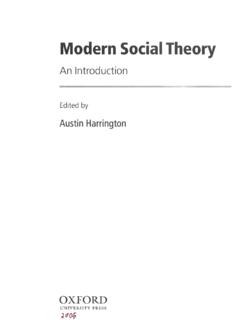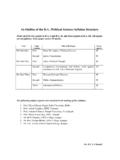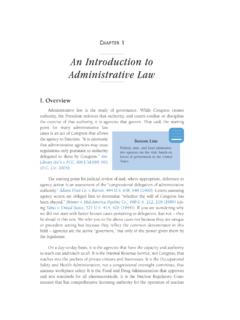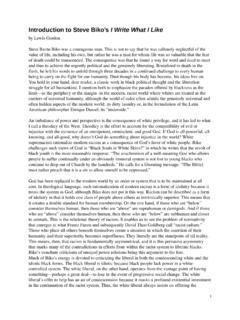Transcription of The Human Condition - sduk
1 The Human Condition The University of Chicago Press, Chicago 60637 The University of Chicago Press, Ltd., London 1958 by The University of Chicago introduction by Margaret Canovan 1998 by The University of Chicago All rights reserved. Published 1998 07 06 05 04 4 5 ISBN: 0-226-02599-3 (cloth) ISBN: 0-226-02598-5 (paper) Library of Congress Cataloging-in-Publication Data Arendt, Hannah. The Human Condition / by Hannah Arendt; introduction by Margaret Canovan. 2nd ed. p. cm. Originally published: Chicago : University of Chicago Press, 1958. Includes index. ISBN 0-226-02599-3 (cloth : alk. paper) ISBN 0-226-02598-5 (pbk.: alk. paper) 1. Sociology.
2 2. Economics. 3. Technology. I. Title. 1998 301 dc21 98-17015 CIP The paper used in this publication meets the minimum requirements of the American National Standard for Information Sciences Permanence of Paper for Printed Library Materials, ANSI Z3 introduction by Margaret Canovan vii Prologue 1 I. The Human Condition 1. Vita Activa and the Human Condition 7 2.
3 The Term Vita Activa 12 3. Eternity versus Immortality 17 II. The Public and the Private Realm 4. Man: A Social or a Political Animal 22 5. The Polls and the Household 28 6. The Rise of the Social 38 7. The Public Realm: The Common 50 8. The Private Realm: Property 58 9. The Social and the Private 68 10. The Location of Human Activities 73 III. Labor 11. "The Labour of Our Body and the Work of Our Hands" 79 12. The Thing-Character o f t h e W o r I d 93 13. Labor and Life 96 14. Labor and Fertility 101 15. The Privacy of Property and Wealth 109 16. The Instruments of Work and the Division of Labor 118 17. A Consumers' Society 126 [ v ] Table of Contents IV.
4 Work 18. The Durability of the World 13 6 19. Reification 139 20. Instrumentality and Animal Laborans 144 21. Instrumentality and Homo Faber 153 22. The Exchange Market 159 23. The Permanence of the World and the Work of Art 167 V. Action 24. The Disclosure of the Agent in Speech and Action 175 25. The Web of Relationships and the Enacted Stories 181 26. The Frailty of Human Affairs 188 27. The Greek Solution 192 28. Power and the Space of Appearance 199 29. Homo Faber and the Space of Appearance 207 30.
5 The Labor Movement 212 31. The Traditional Substitution of Making for Acting 220 32. The Process Character of Action 230 33. Irreversibility and the Power To Forgive 236 34. Unpredictability and the Power of Promise 243 VI. The Vita Activa and the Modern Age 35. World Alienation 248 36. The Discovery of the Archimedean Point 257 37. Universal versus Natural Science 268 38. The Rise of the Cartesian Doubt 273 39. Introspection and the Loss of Common Sense 280 40. T ho ugh t and th e Mo d er n W o r ld V iew 285 41. The Reversal of Contemplation and Action 289 42. The Reversal within the Vita Activa and the Victory of Homo Faber 294 43. The Defeat of Homo Faber and the Principle of Happiness 305 44.
6 Life as the Highest Good 313 45. The Victory of the Animal Laborans 320 Acknowledgments 327 Index 329 [ w 1 introduction Margaret Canovan With the creation of man, the principle of beginning came into the world.. It is in the nature of beginning that some- thing new is started which cannot be expected.]
7 (Below, p. 177) I Hannah Arendt is preeminently the theorist of beginnings. All her books are tales of the unexpected (whether concerned with the novel horrors of totalitarianism or the new dawn of revolu- tion), and reflections on the Human capacity to start something new pervade her thinking. When she published The Human Con- dition in 1958, she herself sent something unexpected out into the world, and forty years later the book's originality is as striking as ever. Belonging to no genre, it has had no successful imitators, and its style and manner remain highly idiosyncratic. Although Arendt never tried to gather disciples and found a school of thought, she has been a great educator, opening her readers' eyes to new ways of looking at the world and at Human affairs.
8 Often the way she sheds light into neglected corners of experience is by making new distinctions, many of them threefold, as if con- ventional dichotomies were too constricting for her intellectual imagination. The Human Condition is crammed with distinctions: between labor, work, and action; between power, violence, and strength; between the earth and the world; between property and wealth; and many more, often established through etymological explorations. But these distinctions are linked to a more contro- versial way of challenging contemporary truisms. For (in what is surely the most unexpected feature of the book) she finds in an- cient Greece an Archimedean point from which to cast a critical introduction eye on ways of thinking and behaving that we take for granted.
9 Indeed, her calm assumption that we may be able to learn impor- tant lessons from the experience of people who lived two and a half millennia ago itself challenges the modern belief in progress. Continual references to the Greeks have added to the sense of bewilderment experienced by many readers of The Human Condi- tion, who have found it hard to understand what is actually going on in the book. Here is a long, complex piece of writing that conforms to no established pattern, crammed with unexpected insights but lacking a clearly apparent argumentative structure. The most urgent question to be addressed by way of introduc- tion is, therefore, what is Arendt actually doing} Both the book's difficulty and its enduring fascination arise from the fact that she is doing a great many things at once.
10 There are more intertwined strands of thought than can possibly be followed at first reading, and even repeated readings are liable to bring surprises. But one thing she is clearly not doing is writing political philosophy as conventionally understood: that is to say, offering political prescriptions backed up by philosophical argu- ments. Readers accustomed to that genre have tried to find something like it in The Human Condition , usually by stressing Arendt's account of the Human capacity for action. Since the book is laced with criticism of modern society, it is tempting to suppose that she intended to present a Utopia of political action, a kind of New Athens.







